JODY’S TRUE STORY OF SADDLEBACK’S SUICIDE MOUNTAIN
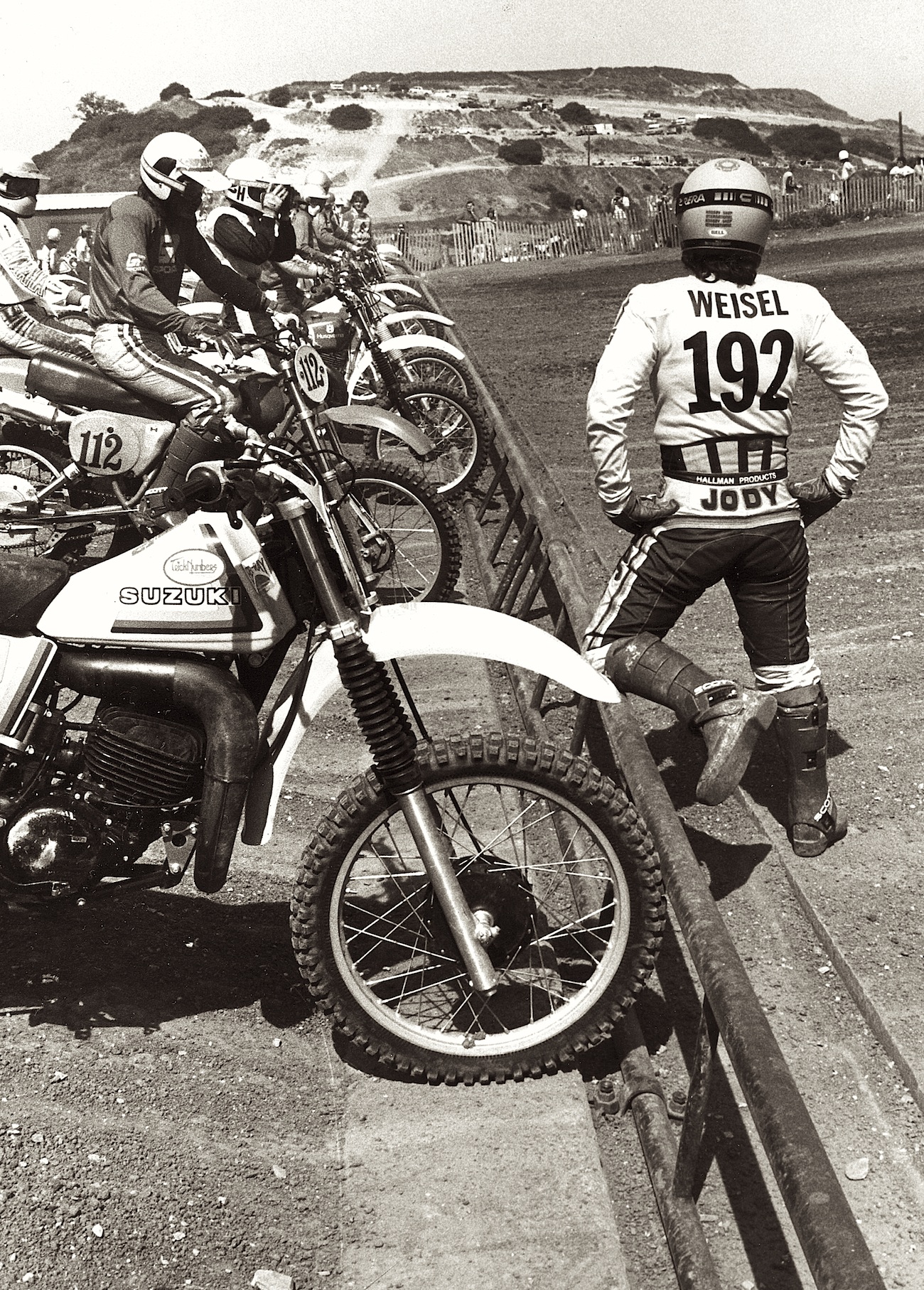 Jody waiting for the start at Saddleback. Suicide Mountain is the hill in the distance with the banners running up it and the telephone pole on the first level.
Jody waiting for the start at Saddleback. Suicide Mountain is the hill in the distance with the banners running up it and the telephone pole on the first level.
THERE IS ALWAYS TENSION IN THE AIR AT A TOUGH TRACK. WILL THEY MAKE IT UP THE HILL? CAN THEY SURVIVE THE DROP BACK DOWN? WHERE DID THEY GO? WHEN WILL THEY POP BACK INTO VIEW? HOW BRAVE WILL THEY BE?
BY JODY WEISEL
Once I got through hating Saddleback Park, I began to love the place. When I first set foot on the rock-hard adobe dirt of Orange, California’s motorcycle playground in the early ’70s, I was fresh off of the Texas circuit of Strawberry Hill, Paradise Valley, Lake Whitney, Mosier Valley and Rio Bravo. To a relatively young Texas racer, seeking fame and glory in SoCal, the linoleum-like surface of Saddleback might as well have been the lunar landscape of the moon.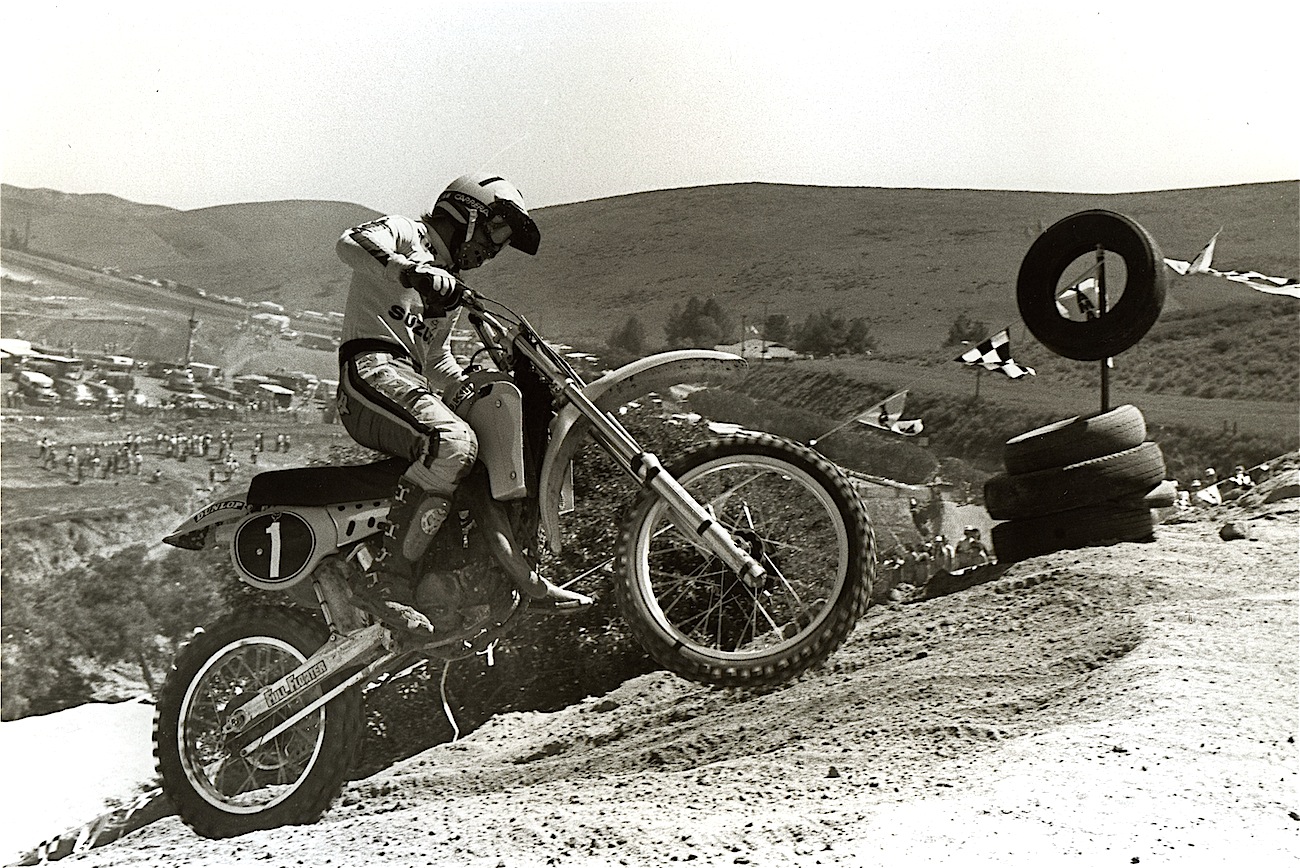 This is the view down Santiago Canyon Road from the top of Suicide Mountain. Now that Mark Barnett is at the top, he has to navigate the steep drops back to the bottom.
This is the view down Santiago Canyon Road from the top of Suicide Mountain. Now that Mark Barnett is at the top, he has to navigate the steep drops back to the bottom.
Luckily, I rode at Saddleback every day of the week with my buddy Lance Moorewood. Lance and I lived down the street from each other in Norwalk, California, and we hung out together. Lance, as a professional motorcycle racer, disdained the idea of working for a living, and since I had to go to Saddleback for my work as a test rider, we inevitably traveled together (eventually spending way too much time together while on the road for the 1977 AMA 125 Nationals). It didn’t hurt that Lance’s dad, Ted Moorewood, was the promoter of the Saddleback National (along with the Escape Country National, running the NMA and owning Myerscough Machines).
I don’t know how it happened, but with a lot of coaching from Lance Moorewood and four-time 250 Champion Gary Jones, I learned how to go fast on clay (make that semi-fast on clay). Little microscopic ridges that I never worried about in the loam of Mosier Valley suddenly became visible to me. And these tiny wrinkles made all the difference in the world. To go fast at Saddleback, you had to weight the outside footpeg, trust your tires (we ran Metzelers up until the Bridgestone M22 was introduced in 1981), brake slide into hairpins and believe that a small ripple, rill or ridge in the dirt was going to be sufficient to careen you around a corner.
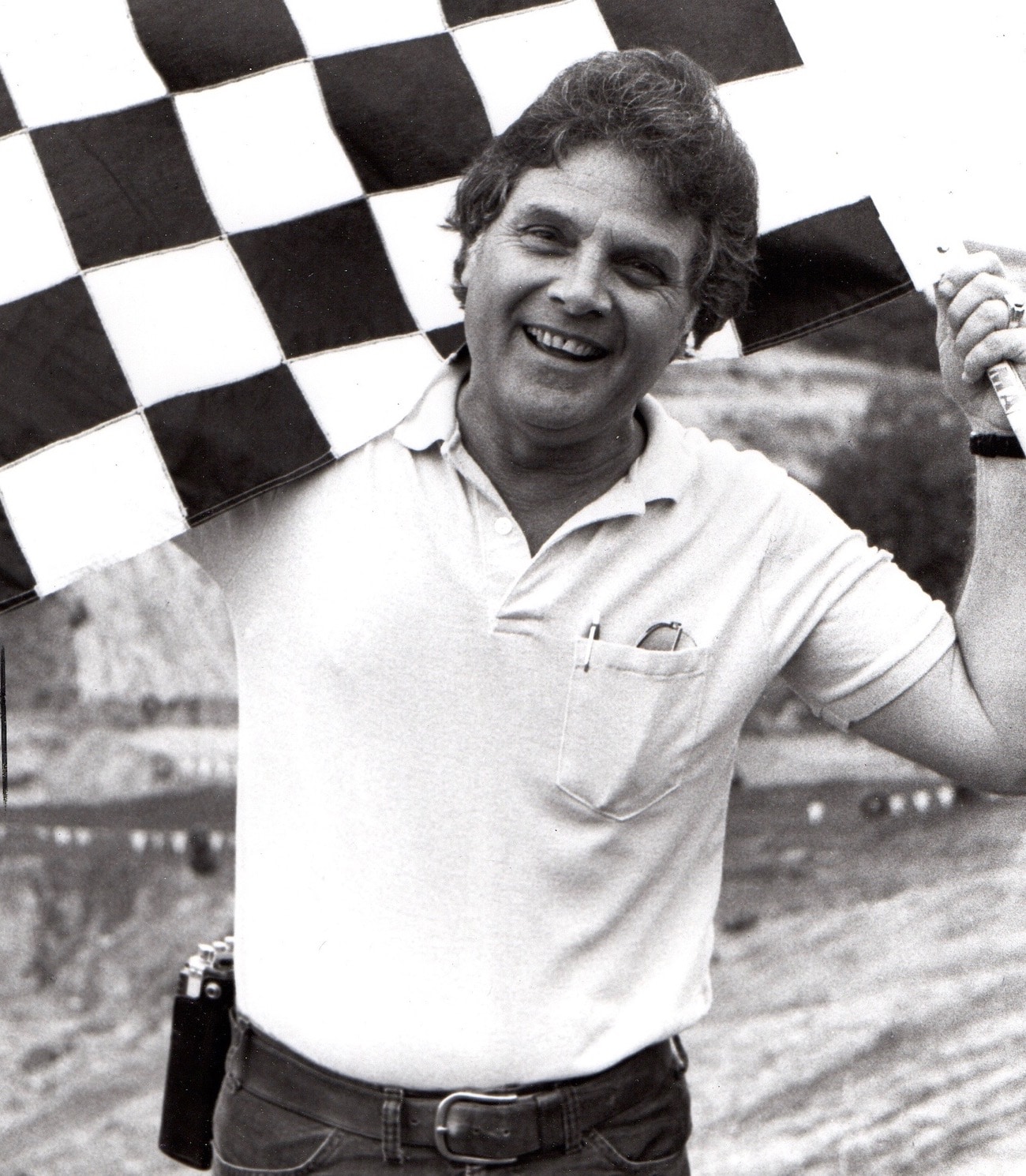 Saddleback and Escape Country National promoter Ted Moorewood.
Saddleback and Escape Country National promoter Ted Moorewood.
Ever since that day in the early ’70s until this day, I considered myself a “Saddleback Specialist.” For those too young to remember Saddleback, it was a wonderland for offroad motorcycle riders. The 700-acre park was located about ten miles east of Disneyland and included two motocross tracks, a BMX track, a dirt track, multiple hill climbs (including the famous Matterhorn ), a trials area and miles of trails. It was open every day of the week and held races on Saturdays and Sundays.
SoCal motocross in the ’70s was a thriving community. It was possible to race five days (and nights) a week at places like Ascot, Irwindale, Corona, De Anza, Lyons Drag Strip, Muntz, Claude Osteen, Baymare, Cycle Haven, Arroyo Cycle Park, Orange County Raceway, Rawhide, Escape Country and the “Big Three” — Saddleback, Carlsbad and Indian Dunes. And back in those days, everybody raced. The concept of “professional practice riders” hadn’t been invented. If you didn’t race, you were a trail rider. For me, Saddleback was my home track — more like my real home, based on the number of hours I spent at the place.

Mark Barnett starts to go airborne. Technically, everybody jumped up Suicide Mountain, but only a handful made it to the next level.
Lance and I were always telling his dad, Ted Moorewood, how to design his AMA National tracks. We knew, with the certainty of youth, what he could do to make the Saddleback 125/250/500 National more exciting (back in the day, all three National Championship classes raced on the same day). Ted listened to us (but he almost always laughed at our ideas). But, he did let us help (especially when he promoted the famous grass track National at Trabuco Canyon’s Escape Country track, but only because it was on the side of the hill and he needed us for grunt work).
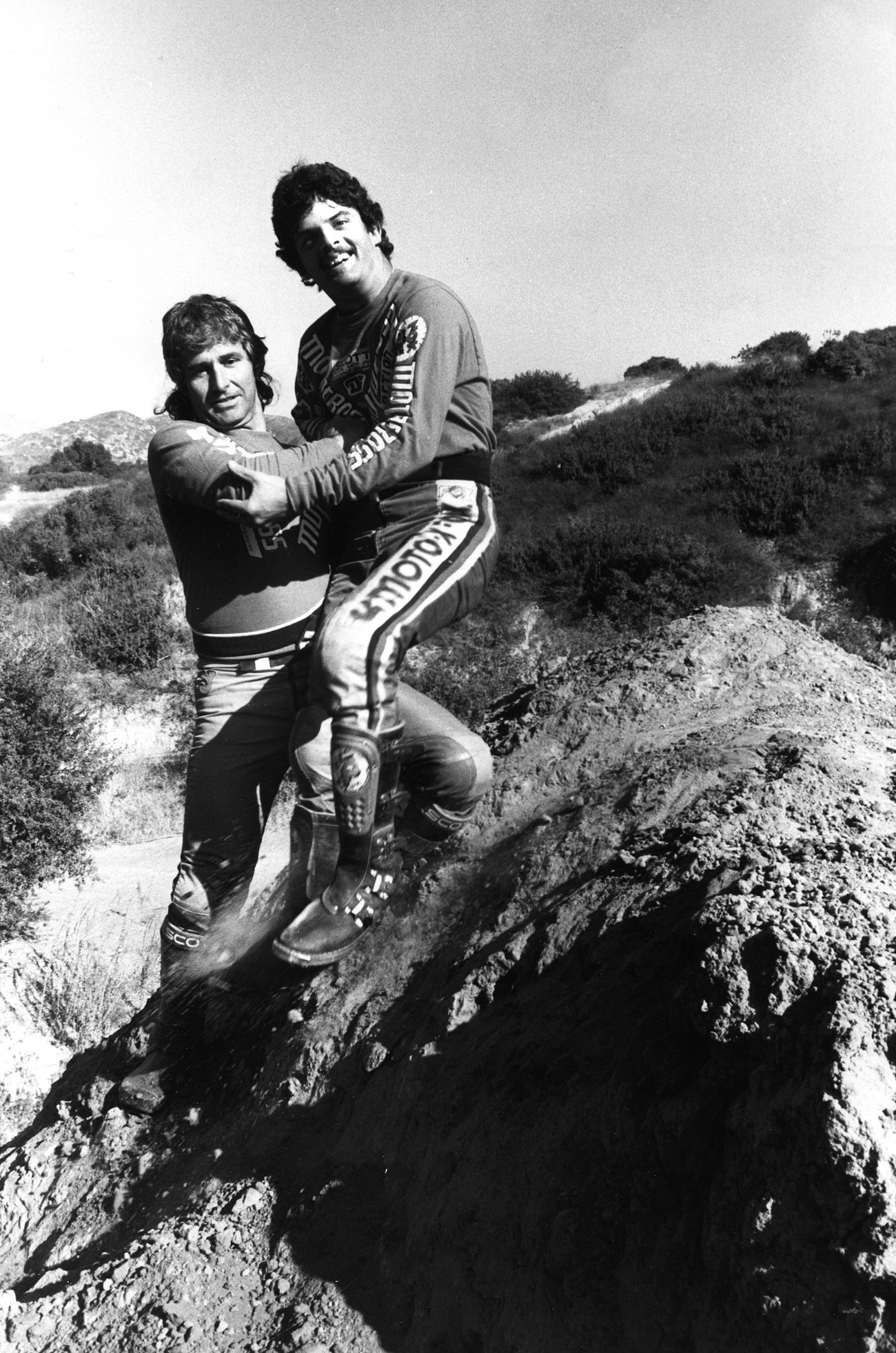 Although Jody Weisel (left) and Lance Moorewood (right) helped build the Saddleback National track, they spent more time goofing around than working and readily admit that Suicide Mountain was not their idea.
Although Jody Weisel (left) and Lance Moorewood (right) helped build the Saddleback National track, they spent more time goofing around than working and readily admit that Suicide Mountain was not their idea.
TODAY, AS THE TRACK DESIGNER OF THE GLEN HELEN 250/450 NATIONALS, I DRAW A LOT ON MY EXPERIENCES AT SADDLEBACK. THE GLEN HELEN NATIONAL’S BIG HILLS ARE MY PERSONAL HOMAGE TO SADDLEBACK PARK.
And as much as Lance and I would love to say that we invented the Magoo Double Jump and Suicide Mountain, we didn’t have a thing to do with either one. We were there. We were asked for our advice. But, for the most part we were relegated to heavy lifting, doing test laps and banner stringing. Today, after designing Glen Helen’s 250/450 National and USGP tracks for 20 years, I can say that I drew a lot on my experiences at Saddleback Park, which is where the inspiration for Mt. Saint Helen came from. The Glen Helen National track’s big hills and down-in-the-valley layout are my personal homage to my memories of Saddleback Park.
People buy tickets to motocross races for one obvious reason — to see great riders engage in epic duels (a la Hannah-versus-Howerton at Saddleback in 1981). The problem with modern motocross is that nine races out of ten are runaways. There is little human drama in watching Ricky Carmichael, Jeremy McGrath, James Stewart, Ryan Villopoto, Eli Tomac or Jett Lawrence crush the field. And, in the current era of one-rider-dominance, the key element — drama — is often missing. Without head-to-head racing, the atmosphere suffers, the fans are bored, and the entertainment value goes down.
NO ONE CAN PROMISE A MULTI-RIDER GUNFIGHT AT THE OK CORRAL. BUT ALL IS NOT LOST. SINCE THE FANS APPRECIATE
ALL ASPECTS OF MOTOCROSS, AND SINCE MOST OF THE AMA NATIONAL FANS ARE RACERS THEMSELVES, THE TRACK ITSELF CAN ADD TO THE EXCITEMENT.
No one can promise a multi-rider gunfight at the OK Corral. But all is not lost. Since the fans appreciate all aspects of motocross, and since most of the AMA National fans are racers themselves, the track itself can add to the excitement. A lap of Saddleback Park started with Banzai Hill, transitioned in Webco Hill, swept back to the Magoo Double jump, weaved its way through the gully-like Wedge and then climbed Suicide Mountain. The simple fact that motocrossers remember the names of track obstacles 40 years after the last knobby broke ground at Saddleback is testament to the allure of an exciting race track.
Saddleback and Glen Helen have charisma (other National tracks have equally appealing features, but Saddleback and Glen Helen are kissin’ cousins). There is always tension in the air at a tough track. Will they make it up the hill? Can they survive the drop back down? Where did they go? When will they pop back into view? How brave will they be? How fast can they go? Thus, Glen Helen has Talladega, Shoei Hill, Mt. Saint Helen, the Triple Step-Up and Yamaha Hill.
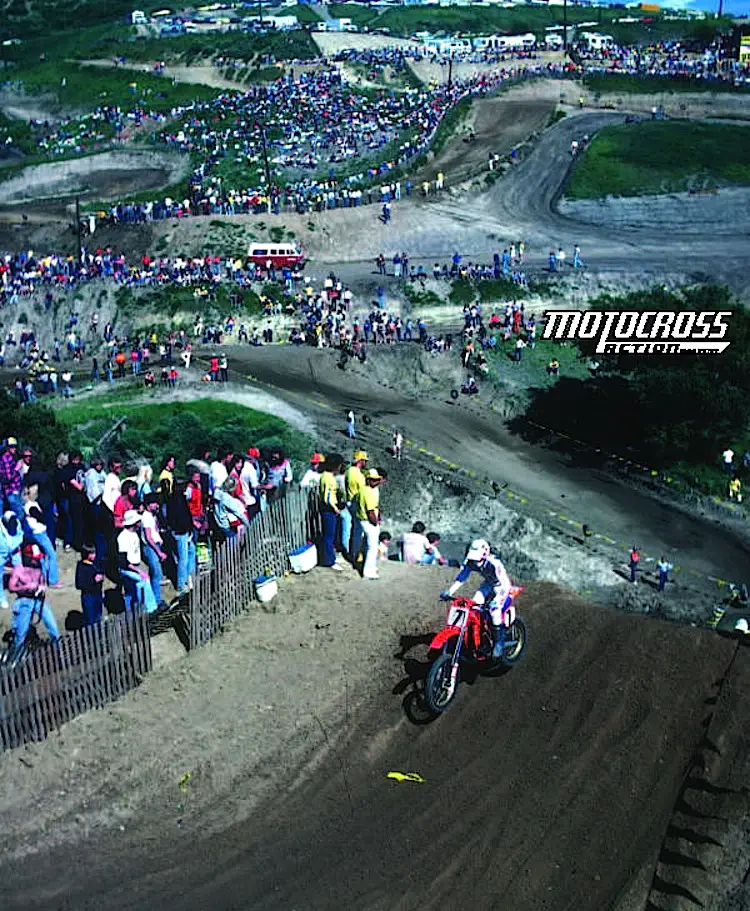
This photo of Donnie Hansen cresting the second of the three levels gives the perspective of just how high it was.
So, if young master Moorewood and my moment of historical significance at Saddleback Park, where limited to advice, test laps and stringing banners, we were still a part of the true story behind Saddleback’s Suicide Mountain.
Suicide Mountain was an accident. It was never meant to be. The idea to build the steepest hill in the sport wasn’t brilliance as much as happenstance. A month before the 1980 Saddleback National, promoters Ted Moorewood and business partner Ron Hendricksen were mapping out the track for the race. Like many promoters of the day, they carried strings of pennants with them to use to lay out the track design before committing to the final layout.
Ted had gone over to Webco Hill to work on that side of the track, while Ron had climbed the hill on the other side to get a better look at the lay of the land. The hill that Ron was standing on was called the “Terraces,” because it had road crossings cut into the steep hillside at various levels up the side of the hill. Each road was wide enough for two vans to park side by side. It was a popular spot for the locals to park on because they could see the whole track from there and still make it to the starting line by riding down the hill next to Santiago Canyon Road.
“TED, TAKE A LOOK AT THIS TRACK IDEA.” THEN RON LAUGHED INTO THE RADIO. TED LOOKED UP FROM HIS VANTAGE POINT ACROSS THE VALLEY AND RADIOED BACK, “DON’T MOVE, I’LL BE RIGHT OVER.”
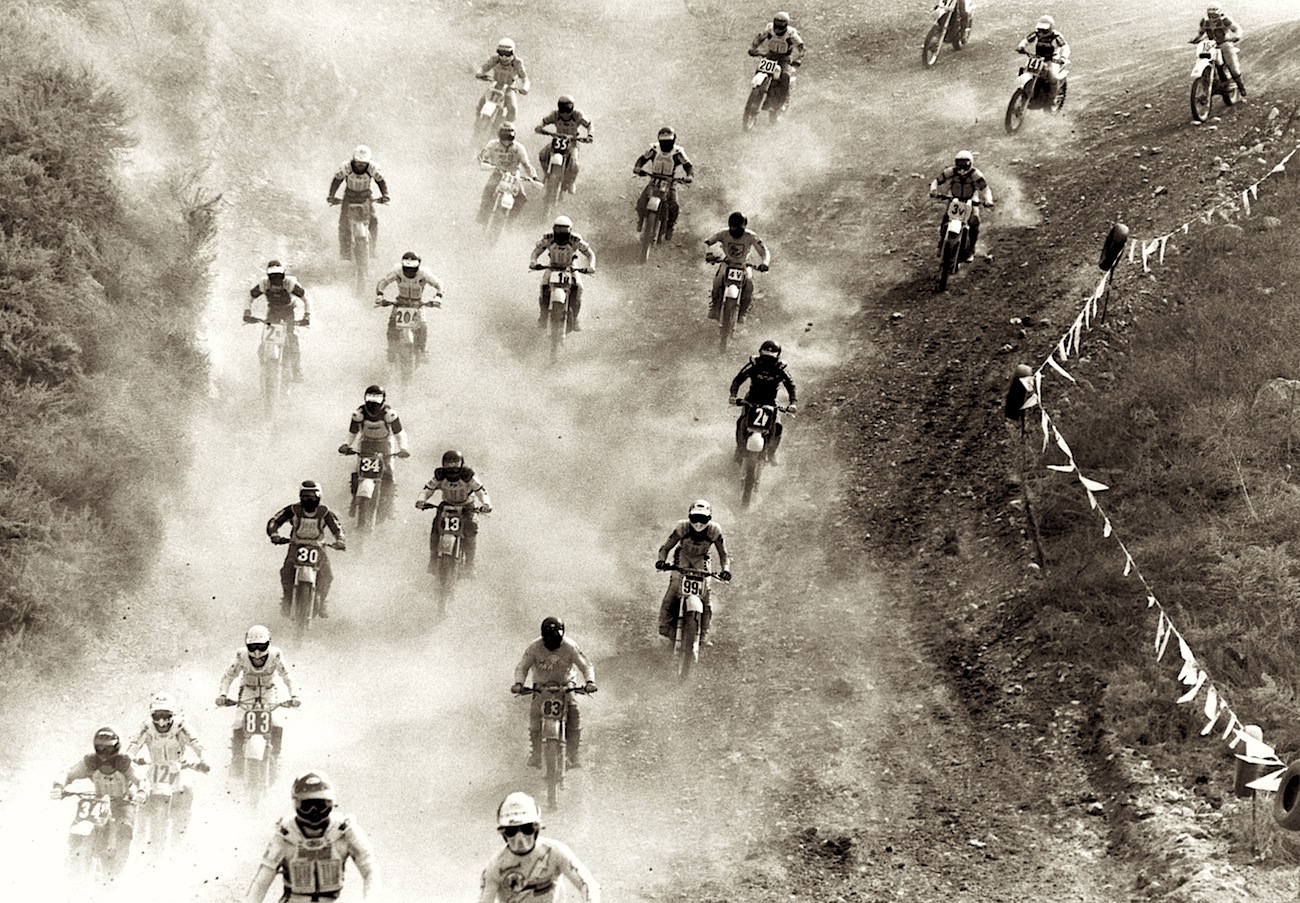 Suicide Mountain was halfway around the Saddleback National track, but the race started with Banzai Hill. By coincidence, that is Jody (left) and Lance (right) in the lead.
Suicide Mountain was halfway around the Saddleback National track, but the race started with Banzai Hill. By coincidence, that is Jody (left) and Lance (right) in the lead.
As Ron Hendricksen walked over to the edge of the cliff that buttressed the road crossings, he accidentally dropped a string of pennants down the bank. It unfurled in a perfectly straight line as it plummeted down to the ground 80 feet below. After dropping the pennant, Ron, who thought Ted would think it was funny that he had bannered off a vertical cliff, called Ted on the radio and said, “Ted, take a look at this track idea.” Then, Ron laughed into the radio. Ted looked up from his vantage point across the valley and radioed back, “Don’t move, I’ll be right over.”
When Ted got over to the Terraces, he said, “Why don’t we run it?” They talked to Saddleback’s bulldozer operator about building the track up the super steep hill. The dozer operator said that there was no way that he was taking a Cat up or down that hill. The two promoters insisted, and at the end of the conversation the dozer guy told Ted and Ron to “Get lost.”
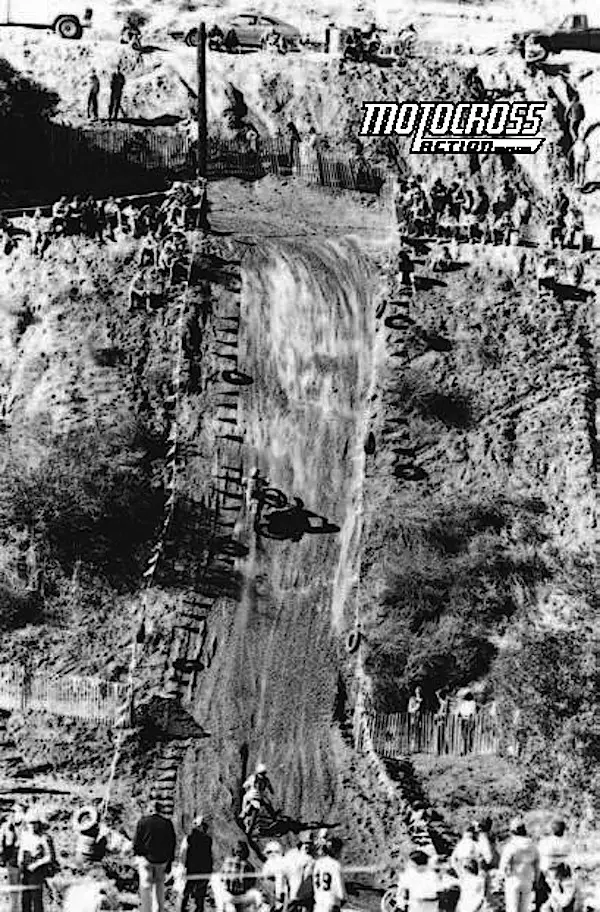
In this 1980 photo, Jody is midway up the first climb. It wasn’t until 1981 that it went to the second level (and then higher in following years).
It could have ended right there, and the world would have never heard of Suicide Mountain. motocross tracks would have been less exciting, and the splendor of giant hills would have never taken off. But it didn’t end there. Ted and Ron weren’t the kind of men that you could tell to “get lost.” They were investing $100,000 in promoting the Saddleback 125/250/500 AMA National, and they wanted the fans to enjoy themselves.
Instead of arguing any further with the bulldozer driver, Ron and Ted brought two shovels to the top of what would become Suicide Mountain and began clearing the brush from the ground. Actually, they assigned their two grunt helpers to do the job. Unfortunately, the hill was so steep that Lance and I couldn’t go up very high from the bottom or down very far from the top. In the end, it looked more like a hill climb course than a motocross course.
For the first year, Suicide Mountain hadn’t earned the name Suicide Mountain. It wasn’t all that spectacular because it only went up to the first terrace, made a left hand turn and came back down to the track. In 1982, the track climbed up to the second terrace, but the riders didn’t jump (largely because they had to turn on what would have been the landing spot). For trivia buffs, the name “Suicide Mountain” was coined in 1982 (before that it was called “Matterhorn Hill” after the Matterhorn Hillclimb in the back portion of Saddleback Park).

This is what’s left of Suicide Mountain today. Lance Moorewood and Rick Henricksen, the sons of the race promoters, made a visit to the track 30 years later and climbed through overgrown brush. Only the tell-tale telephone pole gives a clue that this was once the most intimidating obstacle in motocross.
“THE BIKE FELT LIKE AN ATLAS MISSILE THAT WAS RUNNING OUT OF FUEL AS IT GOT OFF THE LAUNCH PAD AT CAPE CANAVERAL. THE HIGHER I FLEW THE SLOWER THE BIKE SEEMED TO BE CLIMBING.”
For the 1983 125/250/500 National, Suicide Mountain had blossomed into the full flower of its three-level glory. Even before practice started, everyone in the pits was talking about who would be the first to jump from one terrace to the next (the smart money was on Danny “Magoo” Chandler). On the morning of the 1983 AMA National, Ted Moorewood asked his son, Lance, an experienced AMA Pro, to take a parade lap before practice so that announcer Larry Huffman could describe the track to the fans. Lance Moorewood was an incredibly talented rider, but he was also a loose cannon.
Lance “The Trance” Moorewood was brimming with confidence as he rolled onto the track to be the first rider to make a tire track in the Saddleback dirt. No one knows what Lance was thinking, but when he rounded the corner leading towards Suicide Mountain, he pinned the Kawasaki KX125 he was riding and headed for the hill flat-out.
Lance describes it this way: “I was in fourth gear wide open. The jump was totally blind, because the bike was pitched so vertically that all I could see was sky and clouds. I decided to head for the smoothest part of the face, which was on the right side of the lip. I chose it because the rest of the lip was so square-edged that I thought it would kick me over the bars. It was a cool feeling to jump a motocross bike virtually straight up. The bike felt like an Atlas missile that was running out of fuel as it got off the launch pad at Cape Canaveral. The higher I flew the slower the bike seemed to be climbing. I began to fear that I would run out of air speed before making it to the top. The terrace I was aiming for was way up the hillside, but I thought that it was doable, otherwise I wouldn’t have tried. I was wrong! My front wheel made it to the next road crossing, but the impact of the rear wheel on the vertical face drove my spine up through my helmet. I had missed clearing it by three feet, but I rode it out and continued on. Jeff Ward, who was riding the 125 Nationals that year, told me later that when he saw me leave the ground he thought I was dead, but when I almost made it he knew that he could do it.”
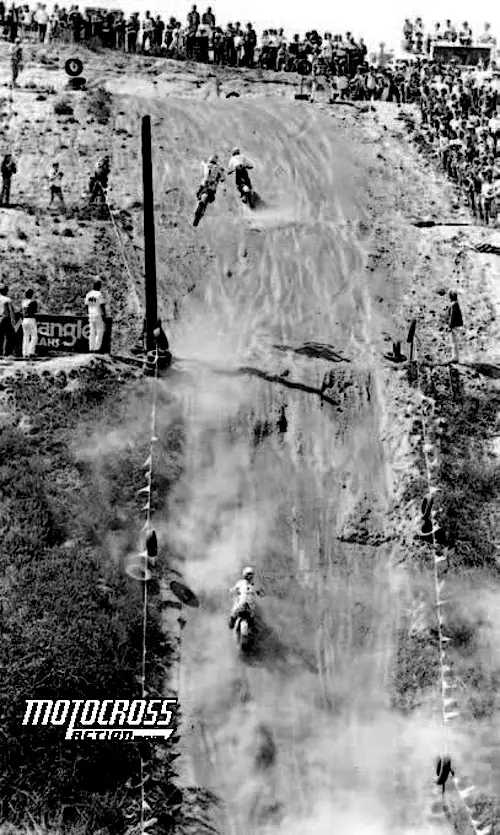
David Bailey launches off the left hand-side of the lip in 1984 with Broc Glover in pursuit.
Now, as practice started it was up to the National riders to play chicken with the hill. For a long time no one even tried — even though Lance Moorewood had proved that it was possible to do it and live — even though his attempt was kinda ugly. The stars were content to do what they had done in 1980, 1981 and 1982—clutching it up each level. Not that lots of riders didn’t think about going for it. Riders would stop in the corner before Suicide Mountain and look up the hill, but they couldn’t build up the nerve.
Finally, Washington’s Phil Larson gave it a strong attempt. He came up short. But, his failed attempted convinced him that he could jump from one level to the next. Three minutes later he came back around, stopped his bike, glared at the hill, dumped the clutch and sailed over the ledge, over the plateau and up to the next terrace. The crowd went wild. Suddenly, out of nowhere came another Northwest rider, Eric Eaton, and now there were two Sir Edmund Hillary’s who had conquered the mountain. Eaton and Larson were on 500s. The crowd waited for a 250 guy to give it a shot. Hundreds of riders rode up the hill before Billy Liles put his Kawasaki KX250 up and over. Now, all eyes focused on the stars of the 125 class. The question was whether or not Jeff Ward would follow up on what he thought when he saw “Lance the Trance” almost make it on a box-stock KX125. The answer came quickly as Jeff became the only 125 rider in 1983 to clear Suicide Mountain.
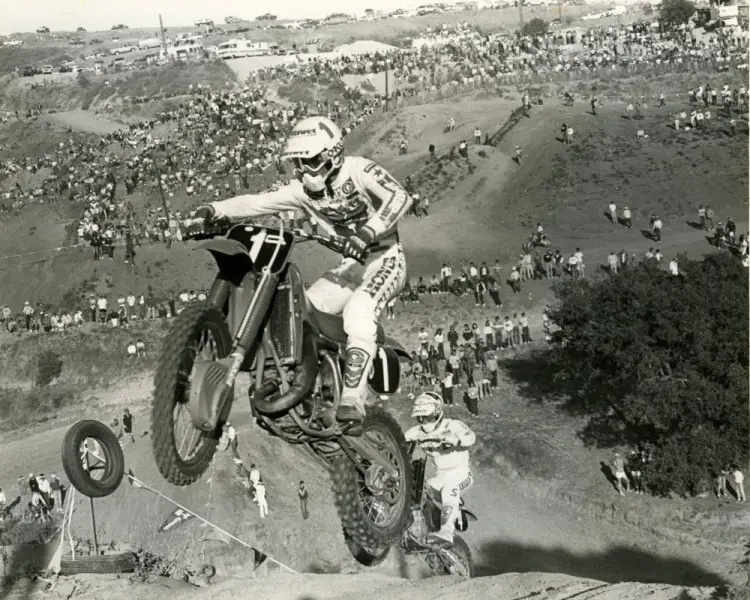
Johnny O’Mara (1) and Jeff Ward (4) with the track below them.
CARSON WASN’T PERFECT OVER SUICIDE MOUNTAIN. ON ONE ATTEMPT HIS REAR WHEEL LANDED ON A FLAG MAN’S ICE CHEST, BLASTING ITS CONTENTS TO SMITHEREENS.
The 1983 honor roll of riders who had etched their names in moto history included Jeff Ward (125), Phil Larson (500), Eric Eaton (500), Goat Breker (500), Broc Glover (500), Warren Reid (500), Danny Chandler (500), Billy Liles (250), Bob Hannah (250), Ricky Johnson (250), Mike Bell (250) and Tom Carson (250). Only 12 riders cleared the jump out of the 160 riders entered that day. Many others claimed to have jumped it (and many did jump high up into the face), and a few may have squeaked over, but most of the claims are based on the fact that every rider jumped, but only a handful made it over the top.
Tom Carson was the least known of the high-flying aerobats. Later in life Tom would say, “I became well known back on the East Coast for jumping Suicide Mountain at Saddleback in 1983. There were only a handful of guys that ever jumped it, and I was one of them. It was a big hill, but being from back east we have big hills everywhere, so it wasn’t like I was awestruck when I saw it. After seeing Ricky Johnson jump it, I thought, If he can jump it, so can I. I jumped it every lap in the race and received a lot of recognition from MXA for it.”
Carson wasn’t perfect over Suicide Mountain. On one attempt Tom whipped his bike sideways to help get it over the lip of the terrace, but the bike sailed off course over the track banners and his rear wheel landed on a flag man’s ice chest, blasting its contents to smithereens. Carson survived and kept on jumping.
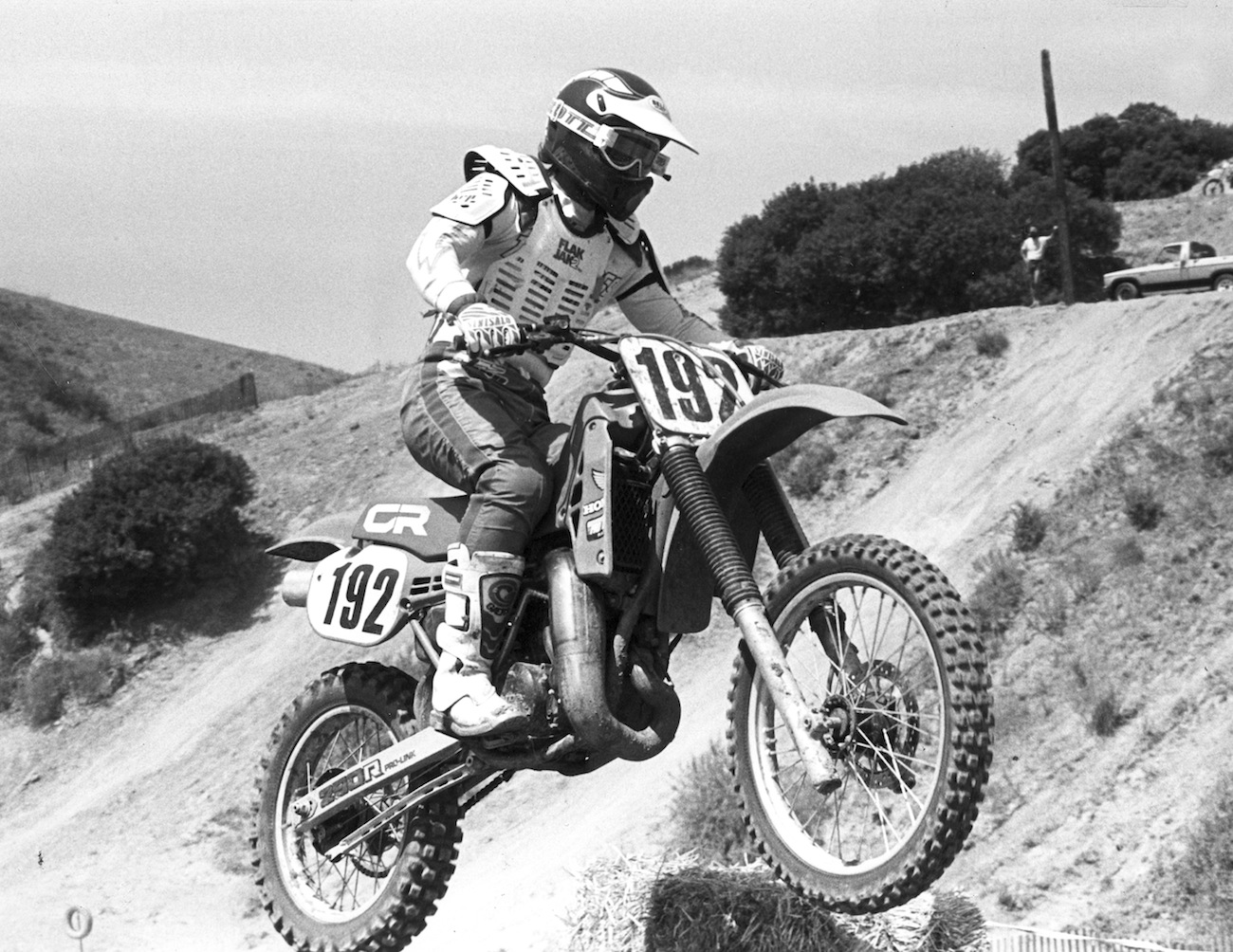 Suicide Mountain was only used occasionally. It is in the background of this photo of Jody and on most weekly races it was used as a place for racers to park. Note the truck parked on the first level, the bike on the second level and the famous telephone pole.
Suicide Mountain was only used occasionally. It is in the background of this photo of Jody and on most weekly races it was used as a place for racers to park. Note the truck parked on the first level, the bike on the second level and the famous telephone pole.
The only casualty of the mountain was Mike Bell. Mike looped out on the hill, cartwheeled from the top to the bottom and cut his hip and elbow. The AMA said he couldn’t race until he got a doctor’s release. Mike rushed down to Chapman General Hospital in Orange, California, and got stitches and a release. Unfortunately, the traffic line to get back into the Saddleback National was so long that Mike was stuck four miles from the track as the first moto was lining up. Luckily for Mike, his brother Brett began to wonder what happened to him and took a Yamahop moped down Santiago Canyon Road until he found Mike sitting in traffic. The Team Yamaha rider made it to the starting line by doubling up on a moped.
The biggest controversy at Suicide Mountain in 1983 came when Danny “Magoo” Chandler crashed on the first plateau on the last lap of moto one. Rather than kick start his works Honda, Danny rolled it down the hill, bump-started it and pulled in front of fourth place rider Alan King. Magoo drag raced the Suzuki factory rider up Suicide Mountain and went on to finish third. The AMA disqualified Magoo for riding backwards on the track. Team Suzuki’s Alan King had not filed a protest.
“I THINK THEY OUGHT TO PUT A DOME OVER SADDLEBACK. I UNDERSTAND THAT THIS IS WHAT THE SPECTATORS WANT TO SEE, BUT IT ISN’T MOTOCROSS. I DON’T THINK THAT SUICIDE MOUNTAIN SHOULD BE ON THE TRACK.”
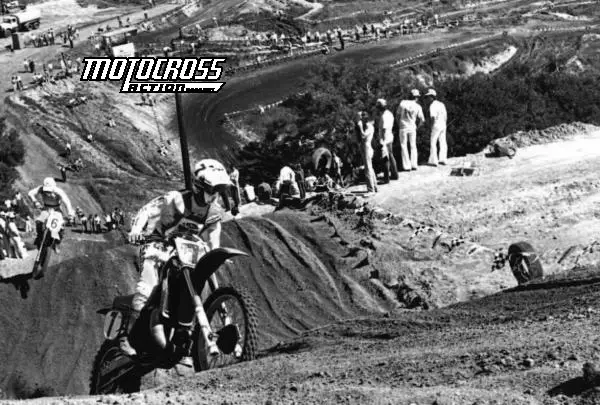
The famous telephone pole was on the first level. Donnie Hansen (7) is on the third level and Broc Glover (6) is cresting the second level.
Not every rider liked Suicide Mountain. Kent Howerton refused to jump the mountain in 1983 (and had the ignominy of having Warren Reid sail directly over his head). So when the 1984 AMA 125/250/500 Saddleback National rolled around, Howerton said, “I think they ought to put a dome over Saddleback. I understand that this is what the spectators want to see, but it isn’t motocross. I don’t think that Suicide Mountain should be on the track. It’s just not for me.”
And in 1984, the number of brave souls who launched themselves into orbit was reduced considerably from the 12 of the year before. But the timidity was skewed in a strange way. While David Bailey was the only 500 guy to jump Suicide Mountain (and he only did it occasionally) and Ricky Johnson was the only 250 rider to jump from plateau to plateau, three 125 riders went for it on almost every lap. The tiddler pilots, who shouldn’t have had the power to fly over the terraces, were Johnny O’Mara, Jeff Ward and Doug Dubach.
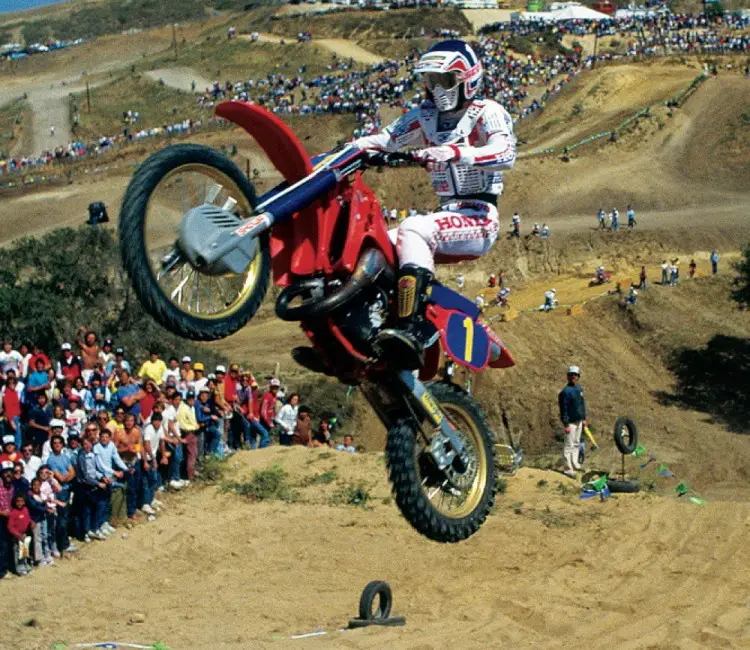
David Bailey just before touchdown.
Doug Dubach, who was riding an RM125 for the Pro Circuit team in 1984, says, “I didn’t know if I could jump it, but I wanted to try. The only reason I made it the first time was because Mitch Payton and Bones Bacon went over to the corner before Suicide Mountain and pulled the track banners back so that I could swing out an extra four feet. It’s funny that four feet would make a difference, but it gave me the confidence to try. After that, I didn’t need their help.”
All in all, when the history books were written, the roll call of the men to jump Suicide Mountain contained only 14 names (12 from 1983 and two new names, O’Mara and Dubach, in 1984). They earned their silver wings.
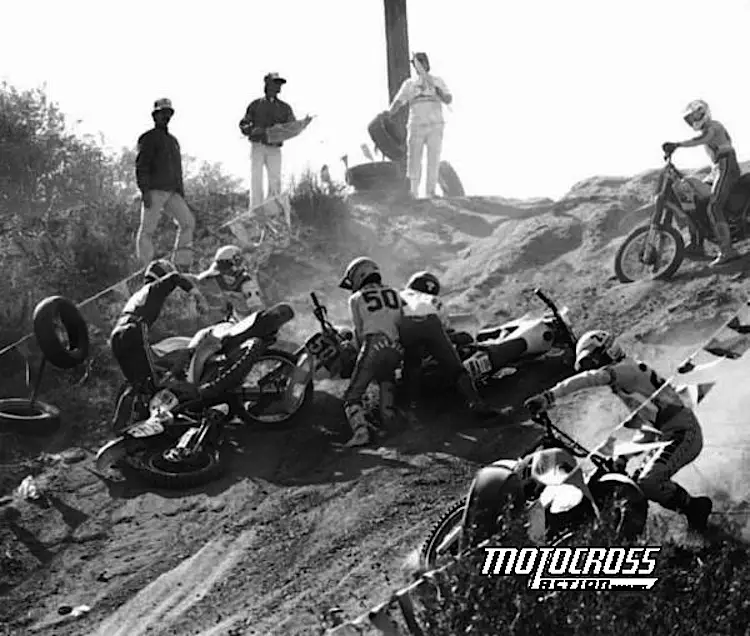 Check out the potholes and bumps. These unlucky riders didn’t even make it to the telephone pole level. If the rider in front of you crashed, as in this 1984 photo, your odds of making the climb were greatly reduced.
Check out the potholes and bumps. These unlucky riders didn’t even make it to the telephone pole level. If the rider in front of you crashed, as in this 1984 photo, your odds of making the climb were greatly reduced.
No one else ever got a chance to ride up Suicide Mountain. I feel extremely lucky and grateful to count myself among the few to ride the hill in a Support Class race, and no, I didn’t jump it. Couldn’t, wouldn’t and was lucky to just make it to the top. Suicide Mountain became a thing of the past when Saddleback Park closed its gates only a few months after the 1984 Saddleback 125/250/500 National. In its heyday (from 1967 to 1984) Saddleback hosted the CMC Golden States, Trans-AMAs, AMA Nationals, World Mini Grand Prix, Motorcycle Olympiad and was the place where most SoCal teenagers learned to become motorcycle racers.
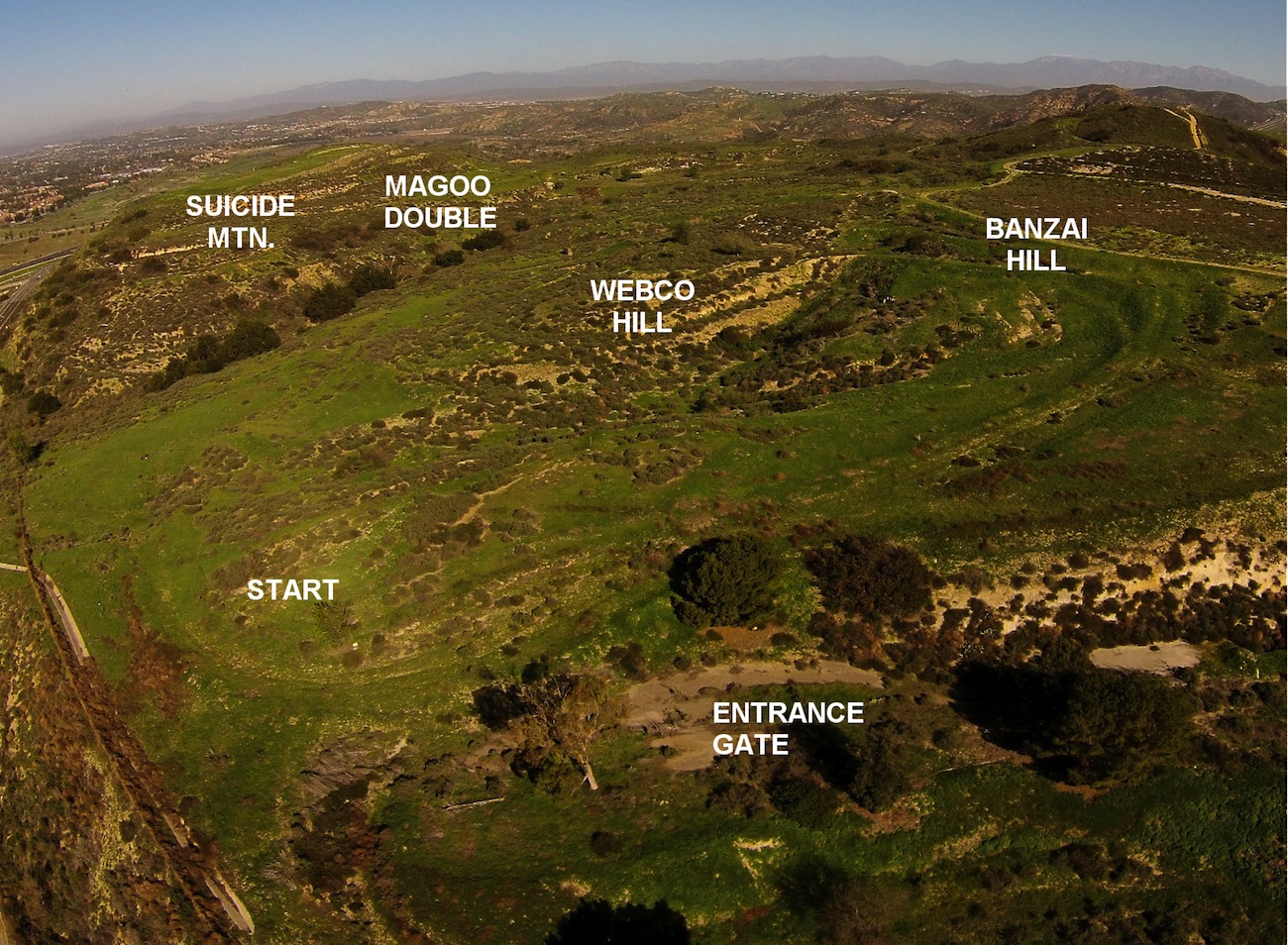 Saddleback Park today with all its famous landmarks. It has since been turned into a nature park for hikers and mountain bikes (at least it didn’t become the master planned housing development that they were planning to put there).
Saddleback Park today with all its famous landmarks. It has since been turned into a nature park for hikers and mountain bikes (at least it didn’t become the master planned housing development that they were planning to put there).
Often when I am flying somewhere in my plane, I swoop low over Saddleback to see what has happened to the place where I misspent my youth. It’s still there and, unlike most abandoned motocross tracks, it isn’t a housing project or a shopping mall. Although nature has reclaimed the land, from above, the outline of the track, including Suicide Mountain, is still visible to those who know where to look (and the telephone pole is still there).
 This is how it was done. Warren Reid almost needs to call air traffic control on his way up and over Suicide Mountain.
This is how it was done. Warren Reid almost needs to call air traffic control on his way up and over Suicide Mountain.
As for me, I still race these many years later against some of the same old Saddleback Specialists from the glory days. Older, slower and grayer, we still light up like teenagers when the conversation turns to Saddleback. We are proud to have been part of something special, and like every adventurer who has been a part of a historic moment, if only a small part, we think that it can never be repeated.
But, not me! I tend to see sports as cyclical in nature. There are always hills to climb and 40 years from now, when the former glory of the Glen Helen National is as a distant memory as the 1984 Saddleback National, and I have achieved room temperature, some old timer (who is only 16 today) will say, “Do you remember that big hill at Glen Helen?”
 “Do you remember that big hill at Glen Helen?”
“Do you remember that big hill at Glen Helen?”
So, if you’ve ever gone to the Glen Helen to race, or watched it on TV, when you saw the riders head full-tilt up Mt. Saint Helen—give a knowing nod to the person next to you in memory of Saddleback Park, the late Ted Moorewood and Suicide Mountain.






Comments are closed.